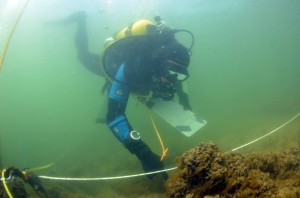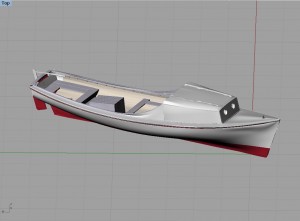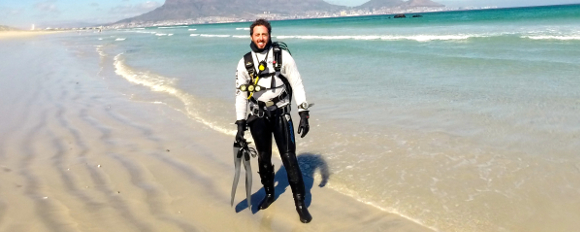Liberal Education Stories: Jeremy Borrelli ’12 (Anthropology)
On a plane ride back to the State University of New York at New Paltz to begin his junior year, Jeremy Borelli ’12 (Anthropology) read an article about archaeological excavations of the pirate Blackbeard’s flagship, the Queen Anne’s Revenge. Borrelli, a member of the men’s swim team, had two passions: archaeology and swimming, so the article opened up a new world of possibilities.
“I realized that you can do archaeology underwater,” said Borrelli. “I love the water, I’ve always wanted to live near the water. It was the best way to combine all those passions.”
Now a graduate student in the Maritime Studies Program at East Carolina University, Borrelli has already added several noteworthy achievements to his resume, including three years with the project that first sparked his interest in the field, the Queen Anne’s Revenge Shipwreck Project at the Conservation Laboratory in Greenville, NC. Borrelli has participated in field excavations of the Queen Anne’s Revenge, and recovered several large artifacts, including cannons and rigging.

Borrelli’s research interests include the development of the harbor in Cape Town, South Africa. For his master’s thesis research, Borrelli spent three months working with Jaco Boshoff, the curator of maritime archaeology at the Iziko South African Museum archaeology lab. Through his association with Boshoff, Borelli joined a field team recovering items from what is believed to be the wreck of the Portuguese slave ship, Sao Jose, which sank in 1794 carrying a large consignment of human cargo, off the coast of Cape Town.
The wreck is part of the African Slave Wrecks Project, established in partnership with Iziko Museums, George Washington University, the National Park Service, South African Heritage Resources Agency and the Smithsonian. The project developed as an extension of Boshoff’s research into the Dutch slave ship, Meermin, which sank in 1766.
The goal for the field season was to map any new features and recover a pulley block, part of the ship’s rigging, for the Smithsonian. Artifacts such as the pulley block, as well as the location of the ship and the historical record, are expected to confirm the ship’s identity. Borrelli said the Sao Jose stands to be a “very significant shipwreck” in the African Slave Wrecks Project.
“It’s an investigation, and that’s what I like about it,” said Borrelli. “You can’t say anything for certain until you have the research to back it up, and that’s something I learned at New Paltz – that process of designing a research strategy, carrying it out and writing up your results.”
“It’s an investigation, and that’s what I like about it.”
Last summer, Borrelli provided mission support for Fabien Cousteau’s historic Mission 31. Cousteau is the grandson of Jacques-Yves Cousteau, and spearheaded the longest underwater science expedition (31 days) inside the Aquarius, the world’s only underwater marine laboratory located off the coast of the Florida Keys 63 feet beneath the sea. Borrelli transported supplies in sealed, steel pressure pots to the Aquarius and escorted other divers to the habitat to interact with Cousteau and his team of aquanauts.
Following the mission, Borrelli participated in archaeological recording and community outreach for local shipbuilding and boating activity in North Carolina’s Outer Banks. As part of his research with the Whalehead Preservation Trust, Borrelli and a colleague produced two 3-dimensional models of locally built watercraft native to Currituck County.

Because the original boats, which were used for duck hunting, are degrading, the models are displayed in exhibits at the Currituck Heritage Park, and enable visitors to view and interact with the boats.
Borrelli, who will defend his thesis in May, said the common thread among all of these projects has been the “ability to think critically and tackle complex problems in a safe, effective and ethically sound manner,” skills he attributes to the liberal arts education he received at New Paltz.
“As a maritime archaeologist, the sites, artifacts and history that we investigate are in unique and often inaccessible environments for many people who are not divers or do not have access to the water,” Borrelli noted. “Furthermore, finding funding for these projects and addressing the issues of working underwater force us to come up with novel techniques and research designs for approaching material [like the Currituck County boats].
“The value of my liberal arts education, within my field, has been to provide me with the capacity and skill set to take maritime cultural material, examine it using unique and often technical methods, and make it applicable within a wider social context. No matter what, people value culture, heritage and history. My liberal arts education taught me how to take the technical aspects of my job and apply them to make this invaluable resource available to those who want to share in the experience.”

